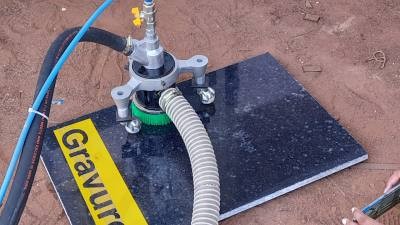Abrasive Garnet Sand For Engraving
Abrasive garnet sand is a natural mineral made of small, not fully round particles. These particles are known for being very hard and lasting for a long time. Abrasive garnet sand is used in many different industries because it can rub and remove material from surfaces in an effective way. One of the main uses of abrasive garnet sand is for engraving. The sand's rough and hard particles make it perfect for cutting into and removing surface parts to create a design or image.
Properties of Abrasive Garnet Sand
Garnet sand has special qualities that make it great for engraving:
- Hardness: Garnet sand scores between 7.5 and 8 on the scale that measures how hard minerals are. This makes it perfect for rubbing and cutting.
- Density: Garnet sand's weight helps it cut and engrave precisely.
- Chemical Composition: It contains certain minerals. Garnet sand is mostly made of almandine and pyrope minerals. These give garnet sand its rough, long-lasting nature.
- Particle Size: It comes in different sizes. Finer garnet such as Garnet Sand 80 Mesh is used for detailed engraving. Coarser garnet sand removes more material faster.
Applications of Abrasive Garnet Sand in Engraving
Abrasive garnet sand is a versatile material employed across numerous industries for intricate engraving applications. Its remarkable properties make it an ideal choice for crafting detailed designs and patterns on various surfaces.
- Glass Engraving: When it comes to glass engraving, garnet sand, and quartz sand shines brilliantly. It is meticulously utilized to create intricate, visually stunning designs and patterns on glass surfaces. From decorative mirrors and windows to delicate glassware, garnet sand's abrasive nature allows artisans to etch intricate patterns with precision and finesse, transforming ordinary glass into exquisite works of art.
- Metal Engraving: In the realm of metal engraving, garnet sand with a sand blasting machine is a pivotal tool. Its abrasive properties make it an exceptional choice for etching designs, logos, and unique serial numbers onto metal surfaces. Whether it's steel, aluminum, or brass components, garnet sand's durability ensures that the engraved markings are not only precise but also long-lasting, withstanding the test of time and harsh environmental conditions.
- Stone Engraving: The intricate art of stone engraving involves the skillful use of garnet sand with a stone shot blasting machine as a tool to etch text, images, and intricate decorative patterns onto surfaces of stone, including the smooth elegance of marble, the rugged beauty of granite, and the natural charm of slate. This ancient technique allows artists to transform these solid, enduring materials into canvases for their creative expressions, leaving a lasting imprint on the unyielding rock.
- Wood Engraving: This ancient art form involves meticulously carving intricate designs, illustrations, and inscriptions onto wooden surfaces. It is a highly skilled technique that has been passed down through generations, renowned for its ability to transform ordinary wooden objects into exquisite masterpiece.
Advantages of Garnet Sand for Engraving
Employing abrasive garnet sand for the granite engraving machine process presents numerous advantageous qualities that make it an exceptionally proficient and versatile material choice. Firstly, garnet sand facilitates intricate and precise engraving, enabling the creation of sharp, well-defined lines and intricate detailing with remarkable accuracy.
- Precision: The utilization of garnet sand enables meticulous engraving with razor-sharp clarity, allowing for the faithful reproduction of even the most intricate designs and patterns with astonishing precision and finesse.
- Efficiency: This abrasive material boasts an impressive rate of material removal, consequently expediting the engraving procedure and augmenting overall productivity levels. Its efficient nature translates into reduced processing times, thereby optimizing operational efficiency and maximizing output capabilities.
- Versatility: Garnet sand showcases remarkable versatility, rendering it suitable for engraving applications in a sand blasting cabinet across a diverse array of materials, ranging from glass and metal to stone and wood. This adaptability enables a broad spectrum of engraving projects, catering to diverse industrial and artistic demands with equal efficacy.
- Minimal Dust Generation: Garnet sand stands out from various abrasive materials used in engraving processes by generating a remarkably low amount of dust particles, thereby fostering a considerably cleaner and more conducive working atmosphere for professionals and hobbyists alike. This remarkable attribute ensures that the surrounding environment remains uncluttered and free from excessive airborne particulates, providing a healthier and more comfortable setting for engraving endeavors.
- Cost-Effectiveness: The cost-effectiveness of garnet sand for engraving is a significant advantage, making it an economical choice that delivers exceptional quality at a reasonable price. This cost-efficient material allows for precise and detailed engravings.
Safety Precautions for Using Garnet Sand
Working with abrasive materials like garnet sand, quartz sand, aluminum oxide, steel shot, steel grit, glass bead, silicon carbide, and tungsten carbide grit for engraving tasks requires taking necessary precautions to ensure safety and reduce potential risks. It is crucial to wear protective clothing, such as coveralls or aprons, to shield your body from exposure to the abrasive particles. Additionally, using goggles or safety glasses is essential to protect your eyes from any flying debris or dust particles that may cause eye irritation or injury. To prevent respiratory issues, it is recommended to wear a respirator or face mask designed to filter out fine particles.

